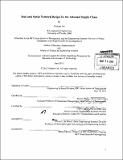Hub and spoke network design for the inbound supply chain
Author(s)
Oti, Olufemi (Olufemi Oluwole)
DownloadFull printable version (9.787Mb)
Other Contributors
Leaders for Global Operations Program.
Advisor
Karen Zheng and Chris Caplice.
Terms of use
Metadata
Show full item recordAbstract
Amazon is one of the world's leading retailers. At the core of Amazon's business model is providing consumers with endless selection, and as a result, the large number of vendors used to provide that selection greatly increases the complexity and cost of operating the inbound supply chain. This growth has also created many opportunities for the company to leverage its size and scale to lower transportation costs and improve supply chain flexibility. This project explores implementing load consolidation strategies within the "Hub and Spoke" distribution framework to provide these benefits. As -65% of total unit volume from the inbound transportation program managed by Amazon is shipped as costly less-than-truckload (LTL) or small-parcel (SP) freight, there are significant opportunities to use consolidation hubs throughout the inbound network to reduce spend on LTL and SP in favor of more cost effective full truckload (TL) shipments. To evaluate the opportunity and provide the inbound team with a useful strategic planning tool, a comprehensive network optimization model was targeted as a project deliverable. After researching the current state of the inbound transportation network through departmental interviews and visits to carrier hubs and fulfillment centers, key inputs were identified to feed the model. The mixed integer program solution uses these inputs to minimize total inbound transportation cost for the network subject to expected transit time performance targets by choosing what consolidation hubs and destination lanes freight should be routed to. Using a data-set of shipments originating in the Southwestern geography, an average saving of 13.7% on annual LTL and SP spend was projected by routing 37% of freight volume through consolidation hubs. Results showed freight density as an important driver in savings. In areas with more originating freight, outbound full truckloads can be filled more readily and hence consolidation opportunities can be taken advantage of more often. This tool and the supporting analyses will help the inbound transportation organization uncover more cost saving opportunities in routing freight through its growing network. In addition to financial cost savings, the strategy will increase supply chain flexibility, reduce environmental impact, and can help increase Amazon's control over the end-to-end inbound transportation network.
Description
Thesis (M.B.A.)--Massachusetts Institute of Technology, Sloan School of Management; and, (S.M.)--Massachusetts Institute of Technology, Engineering Systems Division; in conjunction with the Leaders for Global Operations Program at MIT, 2013. Cataloged from PDF version of thesis. Includes bibliographical references (p. 68-69).
Date issued
2013Department
Leaders for Global Operations Program at MIT; Massachusetts Institute of Technology. Engineering Systems Division; Sloan School of ManagementPublisher
Massachusetts Institute of Technology
Keywords
Sloan School of Management., Engineering Systems Division., Leaders for Global Operations Program.